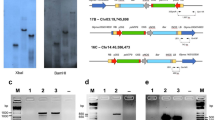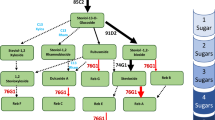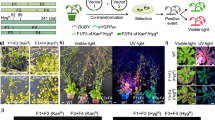Abstract
Potato plants transformed with a chimeric gene encoding a bacterial desensitized aspartate kinase were selected for resistance to the presence of lysine plus threonine in the regeneration and rooting media. Similarly, plants transformed with a chimeric gene encoding a bacterial dihydrodipicolinate synthase were selected for resistance to the toxic lysine analog S-aminoethyl L-cysteine. In both cases, resistant plants were regenerated, and all were apparently transgenic based on their content of dihydrodipicolinate synthase or aspartate kinase activities that were significantly higher, and much less sensitive to lysine and threonine inhibition, than the endogenous activities in control untransformed plants. Our data suggest that these novel selectable markers may be useful for the isolation of transgenic plants expressing relatively high levels of the gene of interest.
This is a preview of subscription content, access via your institution
Access options
Subscribe to this journal
Receive 12 print issues and online access
$209.00 per year
only $17.42 per issue
Buy this article
- Purchase on Springer Link
- Instant access to full article PDF
Prices may be subject to local taxes which are calculated during checkout
Similar content being viewed by others
References
Fraley, R.T., Rogers, S.G. and Horsch, R.B. 1986. Genetic transformation in higher plants. CRC Critical Reviews in Plant Science 4: 1–45.
Bevan, M., Flavell, R.B. and Chilton, M.D. 1983. A chimeric antibiotic resistance gene as a selectable marker for plant cell transformation. Nature 394: 184–187.
Fraley, R.T., Rogers, S.G., Horsch, R.B., Sanders, P., Flick, J., Adams, S., Bittner, M., Brand, L., Fink, C., Fray, J., Galluppi, G., Goldberg, S. and Woo, S. 1983. Expression of bacterial genes in plant cells. Proc. Natl. Acad. Sci. USA 80: 4803–4806.
Herrera-Estrella, L., De Block, M., Van Montagu, M. and Schell, J. 1983. Chimeric genes as dominant selectable markers in plant cells. EMBO J. 2: 987–992.
Vasil, V., Brown, S.M., Re, D., Fromm, M.E. and Vasil, I.K. 1991. Stably transformed callus lines from microprojectile bombardment of cell suspension cultures of wheat. Bio/Technology 9: 743–747.
Herrera-Estrella, L., Depicker, A., Van Montagu, M. and Schell, J. 1983. Expression of chimeric genes transferred into plant cells using a Ti-plasmid derived vector. Nature 303: 209–213.
Waldron, C., Murphy, E.B., Roberts, J.L., Gustafson, G.D., Armour, S.L. and Malcolm, S.K. 1985. Resistance to hygromycin B. A new marker for plant transformation studies. Plant Mol. Biol. 5: 103–108.
Jones, J.D.G., Svab, Z., Harper, E.C., Hurwitz, C.D. and Maliga, P. 1987. A dominant nuclear streptomycin resistance marker for plant cell transformation. Mol. Gen. Genet. 210: 86–91.
Hille, J., Verheggen, F., Roelvink, P., Franssen, H., Kammen, A.V. and Zabel, P. 1986. Bleomycin resistance: a new dominant selectable marker for plant transformation. Plant Mol. Biol. 7: 171–176.
Guerineau, F., Brooks, L., Meadows, J., Robinson, C. and Mullineaux, P. 1990. Sulfonamide resistance gene for plant transformation. Plant Mol. Biol. 15: 127–136.
Stalker, D.M., McBride, K.E. and Malyj, L.D. 1988. Herbicide resistance in transgenic plants expressing a bacterial detoxification gene. Science 242: 419–423.
Streber, W.R. and Willmitzer, L. 1989. Transgenic tobacco plants expressing a bacterial detoxifying enzyme are resistant to 2,4-D. Bio/Technology 7: 811–816.
Shah, D.M., Horsch, R.B., Klee, H.J., Kishore, G.M., Winter, J.A., Turner, N.E., Hironaka, C.M., Sanders, P.R., Gasser, C.S., Aykent, S., Siegel, N.R., Rogeers, S.G. and Fraley, R.T. 1986. Engineering herbicide tolerance in transgenic plants. Science 233: 478–481.
De Block, M., Botterman, J., Vandewiele, M., Docky, J., Thoen, C., Gossele, V., Movva, N.R., Thompson, C., Van Montagu, M. and Leemans, J. 1987. Engineering herbicide resistance in plants by expression of a detoxifying enzyme. EMBO J. 6: 2513–2518.
Bryan, J.K. 1980. Synthesis of the aspartate family and branched-chain amino acids, p. 402–450. In: The Biochemistry of Plants, Vol 5, Amino Acids and Derivatives. B. J. Miflin (Ed. ), Academic Press, NY
Arruda, P., Bright, S.W., Kueh, J.S.H., Lea, P.J. and Rognes, S.E. 1984. Regulation of aspartate kinase isoenzymes in barley mutants resistant to lysine plus threonine. Plant Physiol. 76: 442–446.
Miao, S., Duncan, D.R. and Widholm, J.M. 1988. Selection of regenerable maize callus cultures resistant to 5-methyl-DL-tryptophane, S-2-aminoethyl-L-cysteine and high levels of L-lysine plus L-threonine. Plant Cell Tissue Org. Cult. 14: 3–14.
Rognes, S.E., Simon, W.J. and Miflin, B.J. 1983. Feedback-insensitive aspartate kinase isoenzymes in barley mutants resistant to lysine plus threonine. Planta 157: 32–38.
Bright, S.W.J., Kueh, J.S.H., Franklin, J., Rognes, S.E. and Miflin, B.J. 1982. Two genes for threonine accumulation in barley seeds. Nature 299: 278–279.
Dotson, T.J., Frisch, D.A., Somers, D.A. and Gengenbach, B.G. 1990. Lysine-insensitive aspartate kinase in two threonine-over-producing mutants of maize. Planta 182: 546–552.
Negrutiu, I., Cattoir-Reynearts, A., Verbruggen, I. and Jacobs, M. 1984. Lysine overproducer mutants with altered dihydrodipicolinate synthase from protoplast culture of Nicotiana sylvestris (Spegazzini Comes). Theor. Appl. Genet. 68: 11–20.
Shaul, O. and Galili, G. 1992. Increased lysine synthesis in tobacco plants that express high levels of bacterial dihyrodipicolinate synthase in their chloroplasts. Plant J. 2: 203–209.
Piryns, I., Vernaillen, S. and Jacobs, M. 1988. Inhibitory effects of aspartate derived amino acids and aminoethylcysteine, a lysine analog, on growth of sorghum seedlings; relation with three enzymes of the aspartate pathway. Plant Sci. 57: 93–101.
Yamada, Y., Kumpaisal, R., Hashimoto, T., Sugimoto, Y. and Suzuki, A. 1986. Growth and aspartate kinase activity in wheat cell suspension culture: Effects of lysine analogs and aspartate derived amino acids. Plant Cell Physiol. 27: 607–610.
Boyes, C.J. and Vasil, I.K. K.1987. In vitro selection for tolerance to S-(2-aminoethyl)-L-cysteine and overproduction of lysine by embryogenic calli and regenerated plants of Pennisetum americanum (L. ) K. Schum. Plant Sci. 50: 195–203.
Schaeffer, G.W. and Sharpe, J.R. 1981. Lysine in seed protein from S-aminoethyl-L-cysteine resistant anther-derived tissue cultures of rice. In Vitro 17: 345–352.
Widholm, J.M. 1976. Selection and characterization of cultured carrot and tobacco cells resistant to lysine, methionine, and proline analogs. Can. J. Bot. 54: 1523–1529.
Perl, A., Shaul, O. and Galili, G. 1992. Regulation of lysine synthesis in transgenic potato plants expressing bacterial dihydrodipicolinate synthase in their chloroplasts. Plant Mol. Biol. 19: 815–823.
Shaul, O. and Galili, G. 1992. Threonine overproduction in transgenic tobacco plants expressing a mutant desensitized aspartate kinase of Escherichia coli. Plant Physiol. 100: 1157–1163.
Perl, A., Perl-Treves, R., Galili, S., Shalgi, E., Malkin, S. and Galun, E. 1993. Enhanced oxidative-stress defense in transgenic potato expressing tomato Cu. Zn superoxide dismutases. Theor. Appl. Genet. 85: 568–576.
An, G. 1986. Development of plant promoter expression vectors and their use for analysis of differential activity of nopaline synthase promoter in transformed tobacco cells. Plant Physiol. 81: 86–91.
Bryant, J. and Leather, S. 1992. Removal of selectable marker genes from transgenic plants: needless sophistication or social necessity. Trends in Biotechnology 10: 274–275.
Dale, E.C. and Ow, D.W. 1991. Gene transfer with subsequent removal of the selection gene from the host genome. Proc. Natl. Acad. Sci. USA 88: 10558–10562.
Murashige, T. and Skoog, F. 1962. A revised medium for rapid growth and bioassays with tobacco tissue cultures. Physiol. Plant. 15: 473–497.
Nitsch, J.P. 1969. Experimental and rogenesis in Nicotiana. Phytomorphology 19: 389–404.
Black, S. and Wright, N.G. 1955. β-aspartokinase and β-aspartyl phosphate. J. Biol. Chem. 213: 27–38.
Galili, S., Galili, G. and Feldman, M. 1991. Chromosomal location of genes for rubisco small subunit and rubisco-binding protein in common wheat. Theor. Appl. Genet. 81: 98–104.
Boy, E., Borne, F. and Patte, J.C. 1979. Isolation and identification of mutants constitutive for aspartokinase III synthesis in Escherichia coli K12. Biochimie. 61: 1151–1160.
Odell, J.T., Nagy, F. and Chua, N.-H. 1985. Identification of DNA sequences required for activity of the cauliflower mosaic virus 35S promoter. Nature 313: 810–812.
Gallie, S.R., Lucas, W.J. and Walbot, V. 1989. Visualizing mRNA expression in plant protoplasts: Factors influencing efficient mRNA uptake and translation. The Plant Cell 1: 301–311.
Author information
Authors and Affiliations
Rights and permissions
About this article
Cite this article
Perl, A., Galili, S., Shaul, O. et al. Bacterial Dihydrodipicolinate Synthase and Desensitized Aspartate Kinase: Two Novel Selectable Markers for Plant Transformation. Nat Biotechnol 11, 715–718 (1993). https://doi.org/10.1038/nbt0693-715
Received:
Accepted:
Issue Date:
DOI: https://doi.org/10.1038/nbt0693-715
This article is cited by
-
A protein-independent fluorescent RNA aptamer reporter system for plant genetic engineering
Nature Communications (2020)
-
A study on optimization of pat gene expression cassette for maize transformation
Molecular Biology Reports (2019)
-
Cyanamide hydratase as selectable marker in potato
Plant Cell, Tissue and Organ Culture (PCTOC) (2014)
-
Recent advances in development of marker-free transgenic plants: Regulation and biosafety concern
Journal of Biosciences (2012)
-
Aminoglycoside antibiotics: structure, functions and effects on in vitro plant culture and genetic transformation protocols
Plant Cell Reports (2010)



